For the readers of Search Engine Journal, the idea of using Google Analytics to monitor daily traffic is a no-brainer. To make effective online business decisions, we must have an idea of where traffic is coming from and what visitors are doing while there.
Unfortunately, for many marketers and business owners, their Google Analytics usage is relegated to a few basic, top-level charts (of questionable value).
There is so much more to Google Analytics than traffic data.
Google Analytics has a wide variety of features that most marketers aren’t taking advantage of. By ignoring the full functionality of Google Analytics, your business could be missing out on valuable insights worth thousands of dollars in potential revenue.
Content marketing effectiveness, in terms of increasing brand awareness and lead generation, is restricted to the data you have at your disposal. Quality data informs better business decisions. Companies regularly pay large sums of money for market research and consumer insights—much of which you can find in your own analytics.
Here are six ways to use Google Analytics that you haven’t thought of, but should start doing today.
1. Create a Custom Dashboard
One of the common annoyances about Google Analytics is having to dig through the different menus to find the information you are most interested in. However, there’s a convenient feature that completely solves this—custom dashboards.
At the top of the menu, click on Dashboards and then New Dashboard.
This process allows you to create a customized dashboard that displays all of the metrics you care about most. You can create multiple dashboards, as well.
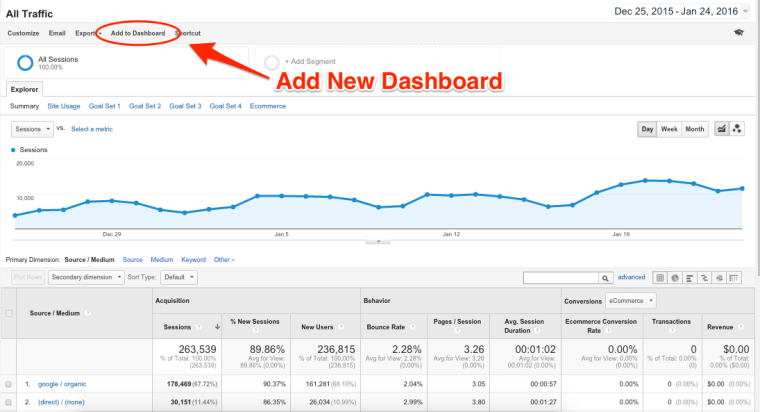
Next time you access your analytics, you’ll have everything you need in one place and won’t have to chase it down.
2. Find Your Worst Performing Pages
Most of the time, we like to look for the most popular pages on our website. This is helpful for coming up with new blog post ideas.
But opportunity also lies in identifying your worst performing pages. This process is how you find holes in your content and search engine marketing strategy.
Ideally, you want to keep prospects on your site long enough to convert them from lead or customer.
For this reason, you need to go to the Behavior tab in the Google Analytics menu.
Then click Exit Pages under the Site Content menu.
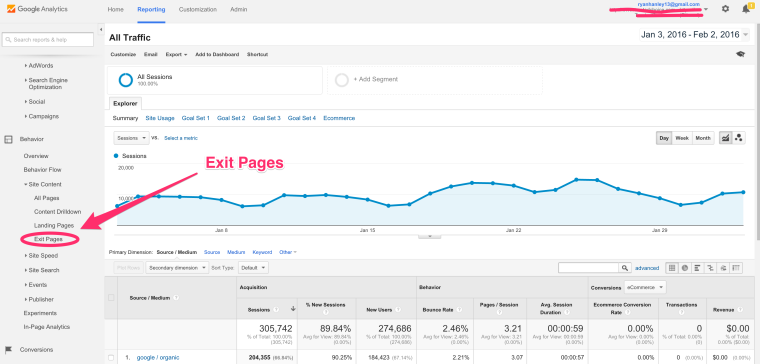
This process will show you the pages where prospects most often exit your website.
With that information, you can then analyze these pages and look for ways to keep prospects engaged with your website. You might have to change the design or re-write the content—depending on how important the page is.
3. Monitor Site Speed
The performance of your website is an overlooked SEO factor that deserves your attention. Slow load times send prospects away to other websites that instantly load. Thanks to smartphones and social media, we have less patience than ever.
Under the Behavior tab, you’ll see a menu item for Site Speed.

The Site Speed menu provides a list of your fastest and slowest loading pages, along with other information regarding load times. What’s really nice is Google Analytics has a sub-menu, Speed Suggestions, where they provide specific solutions to speed up your page load times for each page.
If you find issues, check out this list of 18 plugins to speed up your site.
4. Study Behavior Flow
In the Behavior tab, you will see Behavior Flow, which provides a flow visualization of the behavior on your website. It looks confusing at first, but this function can be incredibly valuable when you learn to use it.
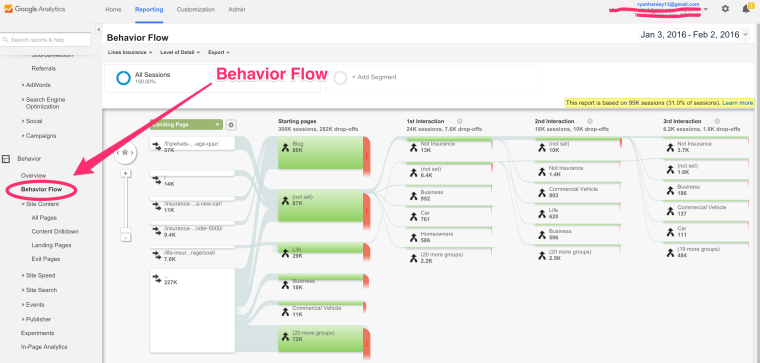
Behavior Flow shows you the most common patterns of behavior on your website, based on parameters that you can choose.
By default, it will show you which page most people land on, where they go to next, and where they keep going until they finally leave.
This process helps you identify which pages keep prospects engaged with your website, which pages send people away, and which patterns string together most often.
Look for which content sends the most traffic to your lead generating or sales pages. With this data, you can create more complimentary content that turns prospects into leads and, eventually, customers.
5. Start Using Intelligence Events Alerts
Daily activity on your website tends to be predictable. However, some events cause unusual changes in traffic—such as a blog post randomly going viral or getting linked-to by an influencer in your industry.
Wouldn’t it be nice to know when these things happen, without having to monitor your analytics 24/7?
You can, by setting up Intelligence Events.
Go to Intelligence Events Overview and click Custom Alerts.
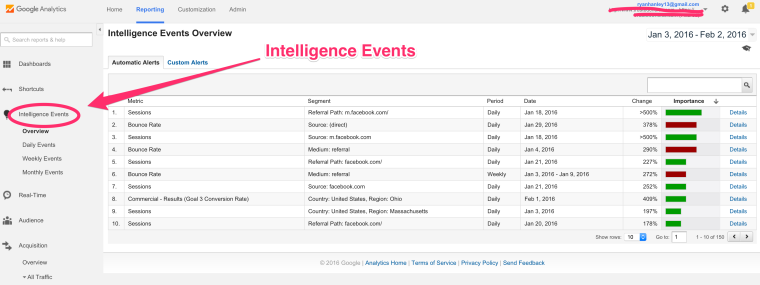
From there, you’ll be able to setup automatic emails (or text messages) that alert you when specified events occur, such as a spike in traffic.
These are real-time signals triggered by website activity.
6. In-Page Analytics
Sometimes you need to put yourself in your prospect’s shoes to understand their perspective.
Often we’ll have a page that we think is perfect, but it isn’t driving traffic through the right links. Wouldn’t it be nice if we could see where our website visitors were clicking?
This is where In-Page Analytics shines.
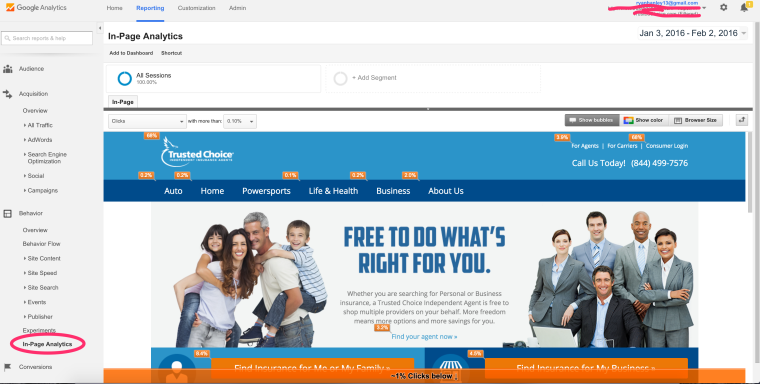
In-Page Analytics allows you to look at your website and see percentages above links that represent the number of clicks those links are getting on that page. You can use this to spot trends, such as people not noticing the links towards the bottom of the page.
Using this feature is easy, you simply click on the Behavior tab and go to In-Page Analytics at the bottom of the menu to get started.
The Rub
Google Analytics is a data goldmine for your website.
You’re doing your business a disservice if Google Analytics is simply a way to check your high-level traffic data. By taking a deeper look into Google Analytics, you’ll find valuable insights into business opportunities you may have otherwise not known existed.

Image Credits
Featured Image: Ingvar Bjork/Shutterstock.com
All screenshots by Ryan Hanley. Taken January 2016.
Unfortunately, for many marketers and business owners, their Google Analytics usage is relegated to a few basic, top-level charts (of questionable value).
There is so much more to Google Analytics than traffic data.
Google Analytics has a wide variety of features that most marketers aren’t taking advantage of. By ignoring the full functionality of Google Analytics, your business could be missing out on valuable insights worth thousands of dollars in potential revenue.
Content marketing effectiveness, in terms of increasing brand awareness and lead generation, is restricted to the data you have at your disposal. Quality data informs better business decisions. Companies regularly pay large sums of money for market research and consumer insights—much of which you can find in your own analytics.
Here are six ways to use Google Analytics that you haven’t thought of, but should start doing today.
1. Create a Custom Dashboard
One of the common annoyances about Google Analytics is having to dig through the different menus to find the information you are most interested in. However, there’s a convenient feature that completely solves this—custom dashboards.
At the top of the menu, click on Dashboards and then New Dashboard.
This process allows you to create a customized dashboard that displays all of the metrics you care about most. You can create multiple dashboards, as well.

Next time you access your analytics, you’ll have everything you need in one place and won’t have to chase it down.
2. Find Your Worst Performing Pages
Most of the time, we like to look for the most popular pages on our website. This is helpful for coming up with new blog post ideas.
But opportunity also lies in identifying your worst performing pages. This process is how you find holes in your content and search engine marketing strategy.
Ideally, you want to keep prospects on your site long enough to convert them from lead or customer.
For this reason, you need to go to the Behavior tab in the Google Analytics menu.
Then click Exit Pages under the Site Content menu.

This process will show you the pages where prospects most often exit your website.
With that information, you can then analyze these pages and look for ways to keep prospects engaged with your website. You might have to change the design or re-write the content—depending on how important the page is.
3. Monitor Site Speed
The performance of your website is an overlooked SEO factor that deserves your attention. Slow load times send prospects away to other websites that instantly load. Thanks to smartphones and social media, we have less patience than ever.
Under the Behavior tab, you’ll see a menu item for Site Speed.

The Site Speed menu provides a list of your fastest and slowest loading pages, along with other information regarding load times. What’s really nice is Google Analytics has a sub-menu, Speed Suggestions, where they provide specific solutions to speed up your page load times for each page.
If you find issues, check out this list of 18 plugins to speed up your site.
4. Study Behavior Flow
In the Behavior tab, you will see Behavior Flow, which provides a flow visualization of the behavior on your website. It looks confusing at first, but this function can be incredibly valuable when you learn to use it.

Behavior Flow shows you the most common patterns of behavior on your website, based on parameters that you can choose.
By default, it will show you which page most people land on, where they go to next, and where they keep going until they finally leave.
This process helps you identify which pages keep prospects engaged with your website, which pages send people away, and which patterns string together most often.
Look for which content sends the most traffic to your lead generating or sales pages. With this data, you can create more complimentary content that turns prospects into leads and, eventually, customers.
5. Start Using Intelligence Events Alerts
Daily activity on your website tends to be predictable. However, some events cause unusual changes in traffic—such as a blog post randomly going viral or getting linked-to by an influencer in your industry.
Wouldn’t it be nice to know when these things happen, without having to monitor your analytics 24/7?
You can, by setting up Intelligence Events.
Go to Intelligence Events Overview and click Custom Alerts.

From there, you’ll be able to setup automatic emails (or text messages) that alert you when specified events occur, such as a spike in traffic.
These are real-time signals triggered by website activity.
6. In-Page Analytics
Sometimes you need to put yourself in your prospect’s shoes to understand their perspective.
Often we’ll have a page that we think is perfect, but it isn’t driving traffic through the right links. Wouldn’t it be nice if we could see where our website visitors were clicking?
This is where In-Page Analytics shines.

In-Page Analytics allows you to look at your website and see percentages above links that represent the number of clicks those links are getting on that page. You can use this to spot trends, such as people not noticing the links towards the bottom of the page.
Using this feature is easy, you simply click on the Behavior tab and go to In-Page Analytics at the bottom of the menu to get started.
The Rub
Google Analytics is a data goldmine for your website.
You’re doing your business a disservice if Google Analytics is simply a way to check your high-level traffic data. By taking a deeper look into Google Analytics, you’ll find valuable insights into business opportunities you may have otherwise not known existed.

Image Credits
Featured Image: Ingvar Bjork/Shutterstock.com
All screenshots by Ryan Hanley. Taken January 2016.

Post a Comment